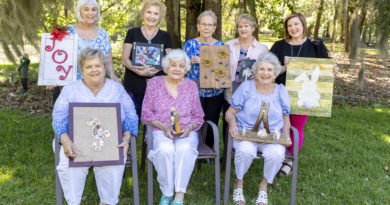Behind the Scenes at Beaufort International Film Festival
story by mary ellen thomspon
photography by susan deloach
What happens behind the scenes at the Beaufort International Film Festival (BIFF)? Ron and Rebecca Tucker, President and Vice-President respectively of the Beaufort Film Society which produces BIFF, are the driving force behind this festival and give us a glimpse of how it works.
Let’s start with how the films get into the festival. The filmmakers choose the festivals which they want to enter; BIFF puts a call out for entries for the next year right after each festival ends in February. There are four deadlines: early bird, regular, late and extended; with each deadline the entry fee increases.
There are two ways that filmmakers know to submit films and one is word of mouth, the other is “FilmFreeway.” FilmFreeway is a company that advertises festivals, almost 5,000 this year, and the filmmakers can submit to those festivals right on the website. Ron explains, “It’s sort of like an on-line dating site for festivals and filmmakers. We’re pitching our festival so it has to look like fun and at the same time, have a high level of respect. There are festivals that show one to two hundred films in different venues and at the same times. This year we will be showing forty films and ours are all at University of South Carolina Center for the Arts (USCB) so there are no time conflicts.”
The next step is selection. Ron says, “We’re picky, more so than even Sundance; we’re truly Indie.” With 300 entries this year, Ron and Rebecca were busy watching films and getting them narrowed down to the forty finalists (not including the Indie Grants films that run Saturday afternoon).They have a panel of eleven judges who help with the selection process, but Ron and Rebecca are the only ones who watch all the film submissions. The categories are: Student, Short, Animation, Documentary, Feature and Screenplay.
The judges have access to the films based on what they are judging – the technical, content, impact and festival fit. There is diversity among the judges; Ron and Rebecca want people who are in the business and from all over, so one lives in Italy, two in Los Angeles, one a Disney producer, some are past time winners, two are actresses. They are given films based on their specialties. For instance a digital animation instructor is a judge in the Animation category only, a past winner for a Documentary is a juror in that category, same with a juror for Shorts, two only judge Screenplays. Ron explains that “The remaining jurors are ‘at large’ and judge all categories. With the exception of Animation and Screenplays, the scores from all the judges are used in the final scoring.” When the films are accepted, the filmmaker receives notification from FilmFreeway but also a personal call from Ron. “We want them to feel special so we thank them for submitting, and for trusting us with their work.”
Part of the process is considering time; this year they have concentrated on shorter films. There will be six features and five documentaries among the forty films. In scheduling, everything is considered – the time of day the film is playing, if the filmmaker is coming to the festival, the question and answer events, time to go to the rest room, time to get a bite to eat, and time to see some daylight. The festival kicks off on Wednesday evening with the Opening Ceremony. On Thursday, there are twelve films and the Screenwriters Reception and Workshop in the evening. On Friday, there are sixteen films starting at 9 a.m. and running until 11 p.m. And, on Saturday there are twelve films ending in the evening with Daughters of the Dust and a panel discussion afterwards. The Awards Ceremony is Sunday evening. Including the Screenwriters Reception and Workshop, that’s thirty nine hours of films in three days. And it’s amazing that there are so many people who stay for many, if not all, of those thirty nine hours.
Last year, attendees came from thirty-seven states and four countries, including seventy filmmakers from around the world.
Among the audience are many of the participants in the films – the filmmakers, directors, producers, actors and actresses. Everything that can be done to make the filmmakers and cast and crew comfortable is taken into consideration. One of the things that makes BIFF so successful is that many of the alumni come back over and over again – if not with another film they’ve made, then as actors (Kathryn Grant produced a movie one year, acted in one another year and will attend this year, just because; Gary Weeks, actor, writer and director, who for a change doesn’t have a film in this festival, will be here as a presenter; VW Scheich and Uyen Le have submitted two films and a screenplay; Margaret Ford Rogers has attended with her screenplays for eight of the eleven years, including this year; and these are only a few of the participants who just can’t stay away), or simply for the fun of it. Other perks are that alumni never pay an entry fee for the festival again and this year a VIP lounge will be set up in the lobby at USCB where certain level sponsors, and filmmakers, can kick back and relax, socialize and schmooze.
There is no festival if there is not an audience. We’ve covered timing and the fact that no matter how few, or many, films you watch, a level of physical comfort is necessary. Those comforts are pretty basic – the seats are comfortable, rest rooms are close by, food is provided by the concession stand and box lunches can be ordered for delivery daily. But the excitement is what the buzz is all about – not only the films themselves, and let’s face it – rarely are all forty films going to appeal to every single person. You really don’t know what is coming, the trailer and the synopsis are teasers, and you can be surprised by the film itself in any direction. What makes this festival feel like family is the interaction with the filmmakers, cast and crew, that attend and participate in the questions and answers sessions after the presentation of the film. They are available in the lobby or at the social events, and want to talk to you about their films, get your impressions, your feedback, and share their vision with you. It’s sort of like a collective hug.
And just as there is no festival without an audience, there is no festival without all the volunteers who make it run like a Swiss watch. It takes about 100 volunteers over the course of the festival who check people in, bartend at the parties, usher, meet and greet, sell tickets are backstage hands, and help Debbi Covington with the aspects of catering the super- delicious food at the closing reception. All volunteers are greatly appreciated for whatever time they give.
Choosing the awards and their winners is another facet of what goes on behind the scenes. Awards are presented in the following categories: Animation, Documentary, Feature, Student Films, Shorts, Screenplay, Best Comedy and Audience Choice. There are awards for Best Actor, Best Actress and Best Director. Ron explains how the award selection works. “The Best Actress, Best Actor and Best Director are nominated by the first tier jurors during the initial screenings. The top scores from each nominated person are calculated. All ‘Best’ nominations have to come from the Finalist Selections. Those nominated for ‘Best’ categories are scored again by the finalists jurors. The winners are determined by the combined scores from all of the jurors. The Best Comedy and Audience Choice are voted on by the audience. On the first day of the screenings, each audience member is given a ballot. On the front, every film is listed and on the back are those that are designated ‘comedy.’ All votes are turned in after the last screening on Saturday. Votes are counted and then revealed on Awards Night.”
This year there will be two additional awards. They are the Robert Smalls Merit and Achievement Award, named for Beaufort’s own Robert Smalls who was a Civil War Hero and United States Congressman, which will be presented to Julie Dash for her extensive groundbreaking work, to include the film Daughters of the Dust. The other is the Behind the Scenes Award which will be presented to filmmaker Brad Jayne. You may visit: www.beaufortfilmfestival.coml.
With all the moving parts assembled and ready to go from behind the scenes, The Beaufort International Film Festival at USCB Center for the Arts is the place to be February 15 – 19. Get your tickets now, join us for the Opening Ceremony and prepare to enjoy the ride right up through the final moments of the Awards Ceremony!



